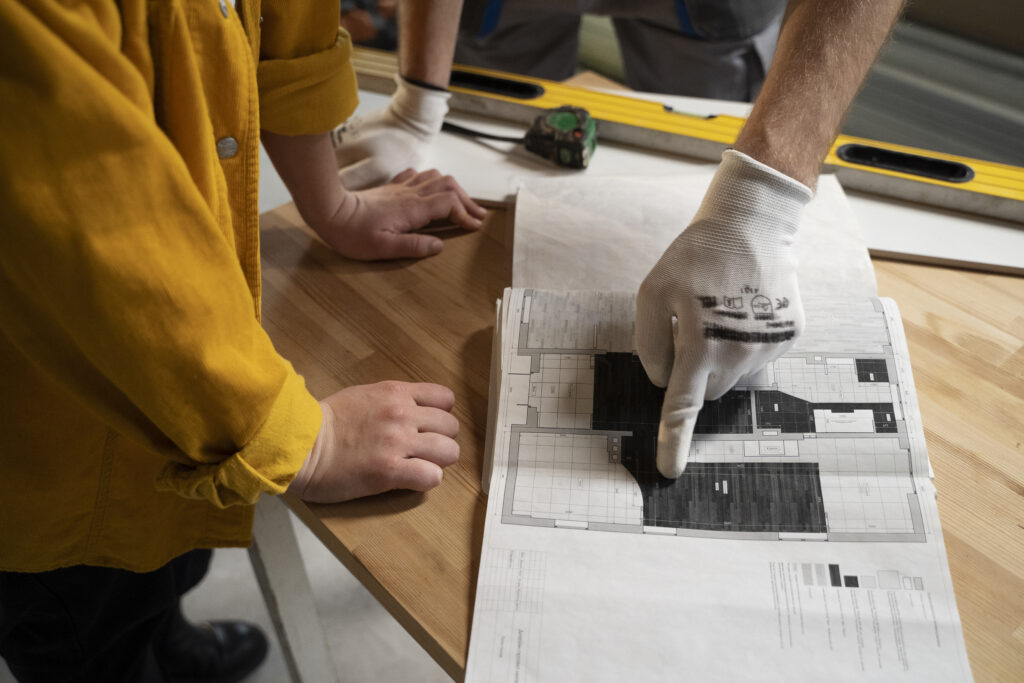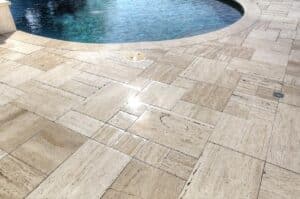Creating a visually appealing and functional outdoor space is a desire for many homeowners. A simple paver walkway can not only add charm to your property but also provide a practical pathway that enhances accessibility.
A paver walkway stands out as a versatile and affordable choice when compared to the most complex and expensive hardscape projects. They can add great value for a relatively low cost of both time and money.
In this article, we will explore the benefits and considerations of installing a simple paver walkway, as well as provide tips for its successful implementation.

The benefits of a simple paver walkway
Aesthetic appeal
A paver walkway is a transformative addition to any outdoor space, instantly enhancing its overall appearance and functionality.
It serves as a focal point and a practical pathway that guides guests and residents through your landscape with style and elegance. By choosing from a diverse range of paver options, you can customize your walkway to perfectly complement your home’s architecture and reflect your personal style.
One of the key advantages of paver walkways is the incredible variety of colors, textures, and shapes available.
Whether you prefer a classic, timeless look or a more contemporary aesthetic, there are pavers to suit every taste. From warm earth tones to cool grays and vibrant hues, you can select pavers that harmonize with your existing outdoor color palette or create an eye-catching contrast.
Durability and longevity
But simple paver walkways offer practical benefits beyond their aesthetic appeal.
They provide a stable and even surface for walking, making it safe and comfortable for both residents and guests to navigate your outdoor space. Pavers are highly durable, resistant to cracking, and can withstand heavy foot traffic, making them an ideal choice for areas that require frequent use.
Pavers are crafted from robust and resilient materials, including concrete, brick, and natural stone, ensuring their ability to withstand the demands of heavy foot traffic and extreme weather conditions.
These materials undergo rigorous manufacturing processes that enhance their strength and durability, making them ideal for constructing long-lasting walkways.
You see, when professionally installed, a paver walkway can last for several decades with minimal maintenance. The installation process involves proper excavation, a well-compacted base, and precise laying of the pavers with adequate joint sand.
These steps ensure the walkway’s structural integrity and prevent shifting or settling over time. The interlocking nature of pavers also enhances their stability and resistance to cracking, as the weight is distributed evenly across the surface.

Maintenance and cost-effectiveness
Maintenance is also a breeze with paver walkways. In the event of damage or staining, individual pavers can be easily replaced, eliminating the need for costly repairs to the entire walkway.
Simple paver walkways require minimal effort and expense.
Regular sweeping or blowing away debris, such as leaves or dirt, helps keep the walkway clean, prevents the growth of weeds and moss between the joints, prevents potential staining, and ensures a beautiful and well-maintained walkway for years to come.
If necessary, occasional washing with water and mild detergent can remove stubborn stains. Additionally, reapplying joint sand and sealing the pavers every few years helps maintain their stability, prevent weed growth, and protect against color fading or surface damage caused by UV rays.
Compared to other outdoor flooring options, such as poured concrete or asphalt, paver walkways offer a much better cost-effective investment.
While the initial installation cost may be higher, the long lifespan and low-maintenance requirements of pavers make them a wise financial choice over time.
Simple paver walkway: planning your installation

Before embarking on the installation of a walkway, thorough planning is crucial to ensure a successful and visually appealing outcome. By considering various factors and incorporating precise measurements into a detailed layout, you can streamline the installation process and overcome any potential obstacles.
Begin by determining the purpose of your walkway. Are you aiming for a functional pathway from one area to another, or is it primarily for aesthetic reasons? Understanding the purpose will help you make informed decisions about the layout, materials, and overall design.
Consider the appropriate size and shape for your walkway. Take into account the amount of foot traffic the path will experience and the available space in your landscape.
For a high-traffic area, a wider walkway may be necessary to accommodate multiple people walking side by side comfortably. The shape of the walkway can be straight, curved, or even meandering, depending on your preferences and the overall design of your landscape.
Survey the area where the walkway will be installed and identify any potential obstacles. These can include trees, large rocks, utility lines, or existing structures like decks or patios.
Take note of their locations and plan the walkway accordingly. If there are obstacles that cannot be moved, consider incorporating them into the walkway’s design or finding alternative ways to work around them.
Use a measuring tape or laser measuring tool to obtain precise measurements of the area where the walkway will be installed. Measure the width, length, and any curves or angles in the path. Be sure to account for any additional space needed for borders, edging, or decorative elements you plan to include.
Once you have collected all the necessary information, create a detailed layout for your walkway. You can sketch it on graph paper or use specialized design software to visualize the path.
Include accurate measurements, the desired shape, and the location of any obstacles or existing structures. This layout will serve as your guide during the installation process.
Choosing the right material
When selecting pavers for your walkway, you have several material options to choose from. Each material offers its unique characteristics in terms of appearance, durability, maintenance, and cost
Concrete pavers are, by far, the most popular choice due to their versatility, affordability, and wide range of available colors, shapes, and textures.
They can mimic the look of natural stone or brick while providing a more budget-friendly option. Concrete pavers are durable, low-maintenance, and can withstand heavy foot traffic.
Natural stone pavers, such as granite, limestone, travertine, and slate, offer a timeless and elegant look to your walkway. They come in various colors, textures, and sizes, providing a unique and natural appearance.
Natural stone pavers are durable, long-lasting, and can withstand different weather conditions. However, they tend to be more expensive than other options and may require occasional sealing or maintenance.
The next material on our list is brick pavers, known for their classic and traditional charm. They come in a range of warm, earthy colors and offer a distinctive, rustic look. Brick pavers are durable, resistant to fading, and provide good traction.
They require a fair bit of maintenance – but can last for a long time. However, they are also more expensive than concrete pavers, although not as much as natural stone pavers.
And finally, let’s talk about porcelain pavers.
Porcelain pavers are a relatively newer option in the market, gaining popularity due to their durability, low maintenance, and modern aesthetic.
They are available in a variety of colors, sizes, and textures. Porcelain pavers offer excellent stain resistance, are resistant to fading, and are highly durable. They can withstand extreme temperatures, making them suitable for various climates.
While porcelain pavers may have a higher upfront cost, their longevity and minimal maintenance requirements can make them cost-effective in the long run.

Professional installation
As you can see, there are many aspects to consider, even when going for a simple paver walkway.
A simple paver walkway project can be tackled from a DIY perspective with enough planning, and if you have at least a little bit of experience with previous hardscape handling.
But if that’s not the case, we highly recommend hiring professional hardscape contractors to help you with your project. They can help you plan a perfect installation as well as choose precisely the right material for your needs.
Here at S&S Pavers, throughout our 13 years of experience in the hardscape business, we have seen many simple installations go bad for a pure lack of preparation or poor skills.
So don’t take any chances. If you’re not sure that you can handle a simple paver walkway installation, your best course of action is to hire a professional you can trust around your area.
And if you happen to be around our area of activity, the Sarasota and Manatee counties, in FL, you can always contact us to provide that help for you.




